There are many reasons we may want to harvest rainwater, be it to supplement our water storage or for use in the garden. Building a rainwater collection system is an excellent idea for preppers to consider
Depending on where you live, the amount of rainwater you could collect may be substantial, meaning that you will need significant storage containers to contain all that rainwater.
Regardless of how you choose to store your rainwater, there may be circumstances in which you would want to conceal the fact that you are harvesting rainwater.
How To Store Rainwater
There are many ways to store rainwater, and regardless of your budget and living situation, you can find an option to build your rainwater collection system.
One popular option is to use store-bought rain barrels, which can be placed beneath the downspouts around your home.
Another option is to use 55 Gallon plastic barrels which can be placed at downspouts like rain barrels or even laid on their side and stacked vertically.
If you plan on storing large quantities of rainwater, large water storage tanks can be fabricated or bought to suit your needs and space. If you want to spend less money, here’s a guide on how to build your own pressurized rainwater harvesting system.
Why Would We Want To Hide Harvested Rainwater?
When it comes to hiding rainwater, there are four reasons why we would want our rainwater storage to be hidden from view.
- It violates local regulations or laws
- To protect from theft
- To conceal the fact that you are a prepper
- Because it is not aesthetically pleasing
Violating Local Laws Or Regulations
I would never condone the violation of any laws or regulations outside an SHTF situation.
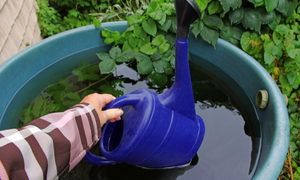
However, that being said, many preppers will still harvest rainwater knowing that they are in violation of local or state laws and regulations.
These people will definitely want to conceal these activities from the view of anyone walking by.
It would also be a good idea to hide your barrels or tanks from aerial surveillance as well. Local governments may use drones to check the backyards of people they suspect to be in violation of any rainwater collection laws.
⇒ Backyard Projects That Might Get You Arrested
At the time of writing this article, there are no federal laws that restrict or prohibit the collection of rainwater.
Still, some local and state laws and regulations limit the amount and methods of collecting rainwater. In some cases, you may be required to obtain a permit to collect rainwater.
Protecting From Theft
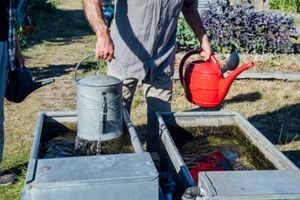 Thieves will steal anything, and your rainwater is not immune to sticky fingers.
Thieves will steal anything, and your rainwater is not immune to sticky fingers.
So while there are likely not going to be gangs of thugs roaming the neighborhood siphoning every rain barrel they see, your neighbors may consider hooking up a hose to your rain barrels in times of drought for their use.
Also, after a disaster or emergency, the gallons upon gallons of fresh water you have in plain view may be too tempting for desperate people.
Concealing The Fact You Are A Prepper
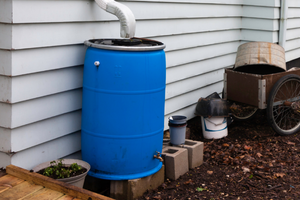
If you have stacks of 55-gallon drums lining the side of your home, your neighbors are inevitably going to ask about them.
I think most of us would let slip that one of the reasons we would be collecting large amounts of rainwater is preparedness.
Related: 7 Weird Things Only Preppers Understand. Do you?
Even if we don’t come out and say it, many people would consider a well-thought-out and constructed rainwater collection system as something that only a ‘crazy prepper’ would do.
We could exercise good operational security (OPSEC) in all other avenues of our lives only to have our rain barrels be the Judas that announces to our neighbors that we are preppers.
Rainwater Harvesting Can Be Ugly
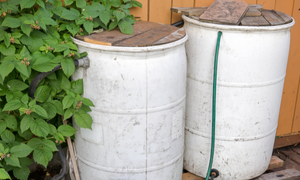 We spend a lot of money purchasing property and want to ensure that our homes look their best.
We spend a lot of money purchasing property and want to ensure that our homes look their best.
Unfortunately, large water tanks, rain barrels, PVC plumbing, or blue 55 Gallon drums all act to reduce our home’s curb appeal and provide a definite eye sore.
Even if we are not worried about theft or legal implications, disguising our rainwater harvesting activities can still be something we should consider.
How Should We Hide Our Rain Water Harvesting Activities?
One of the first things we should do is place all of our barrels or tanks to the rear of our home, so they are out of view from anyone passing on the street.
If the backyard is not an option, using the side of the house can be good too, but it will be more visible and require more care in concealing.
One easy way to conceal rain barrels is to build a fence that encloses the barrels on all sides. If you take the time to make the fence look nice, most people will not give it a second thought.
If you have the time, skill, and materials, you can build an enclosure around your barrels or tanks using the same siding as your house. This will make it look like the enclosure is a part of the original construction of your home.
Related: 11 Looter-Attracting Items You Should Immediately Hide When SHTF
Another good option is to build a shed that will house your rain barrels or water tanks, but this has the disadvantage of needing to run plumbing into the shed from your downspouts which may cause people to wonder what is going on in the shed.
Depending on where you place your tanks or barrels, you can plant hedges or other plants in front of them to screen them from view.
One method I would suggest not to consider is burying the barrels or tanks. If you bury water tanks, you will have to account for using a water pump to get the water from the tanks and up to the surface where you need it. It also prevents you from being able to inspect the tank for potential leaks or contamination.
Collecting rainwater is a fantastic way to supplement your water storage or use it in your garden, but it is also a good idea to conceal these activities for the reasons I spoke about above.
Therefore, if you take the time to build a good rainwater harvesting system, you should also be taking the time to conceal its existence.
You may also like:
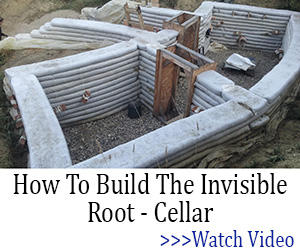 Pioneer Recipes That Survived The California Trail
Pioneer Recipes That Survived The California Trail
The Awesome DIY Device That Turns Air Into Fresh Water (Video)

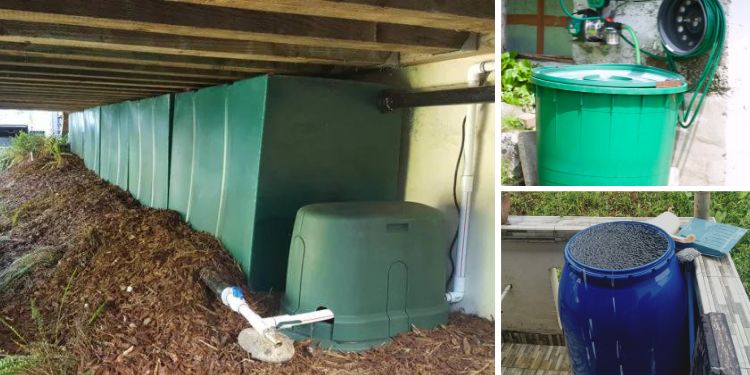













Well the attempt was made.
Rainwater collection isn’t just a prepper thing. There are plenty of conservationists who have rain barrels or larger rain collection systems in their yards. I can drive through my neighborhood and spot several barrels connected to the gutter downspouts. It’s the same with many large business buildings.
It’s the same with the neighborhoods, who for decades have had to provide wet and dry rainwater retention areas to slow the flow of rainwater into the creeks and streams to limit erosions. There are two such wet retention areas within a half-mile of me where people fish and a similar fenced-off wetlands area behind the nearby Walmart.
We’ve had enough rain this fall and over the last two weeks that our ground is saturated, but our lakes are still a bit low from the earlier drought.
As to hiding your rainwater collection system…I wouldn’t worry about drones. Aerial photography, such as Google Maps, is good enough to spot those if they aren’t under cover. Last time I had to have my roof replaced because of a hail storm, the estimator simply typed in my address and determined the number of bundles of shingles in a few seconds based on the aerial photos of the roof of my house. That’s a standard tool for roofers based on the pre-existing photos.
The fence idea might work, depending on how much water you’re collecting. Without extra drainpipes at slight angles running along the house, there’s no way I could get the rainwater from the front of the house to the barrels in the back, and those extra drainpipes would give away the fact that I’m harvesting rain, and be an eyesore in and of themselves. I’d need to limit my rain harvesting to the back of the house because of that.
There can be more complications in Northern Winter States (with basements). Frost depths are average depths. My state is 31-34 inches/average. But if I was in open country with winds blowing– frost depth could easily reach 4-5 feet, with no snow cover and in the coldest of months. So if you plan to trench around a house, all your water could be frozen. It could also be damaged and spill water into your basement. How? Frost soils can swell-push laterally (horizontally) toward your basement foundation up to 2 tons of pressure against the side of your basement foundation. What if it crushed your trench sides and barrels (with water in them). Now you will have wet water probably entering your basement where the basement walls rest on the bottom basement lowest foundation that can have hairline cracks in it due to vertical frost-heave that can stick to walls closer to ground level and sort of “lift them up” just enough to open that crack area of basement bottom foundation and the cement (or cement-block) wall that sits on it. I see frost heave every year on my back porch and in my detached garage.
My opinion for basement dwellers (especially new home buyers) is to position water storage at one end of the home, and stack your containers there, and run city water into them (or rain water if you choose), or Plumb for both just in case. You might also consider buying old water heaters (if the insides are fairly clean), then hooking them together, one after another, and maybe above each other depending on their size. They may hold 40+ gallons each. The plumbing is simple enough. If you have water pressure you can send it up and out through a basement window.
A better solution to examine installing may be a swimming pool with the gallonage you may desire, especially if you are in warmer areas. It would be like a “fairly clean” cistern that was used in the 1800s-early 1900s to catch rain run-off. You could swim in it. collect water in it, cover it, build a deck around it (sort of like fencing). If you need water, drop a bucket into it .
If you insulate the ground around it in any state (even those touching Canada), the depth (laterally or vertically) of ground frost will be severely limited (good for the interior of your pool. Ice fisherman do drill large and deep holes in ice with either a power or hand-turn manual drill if your pool top water freezes. After a time, you could cover it over with wood (and hinge doors) on your deck and tell your neighbors that it leaked too much, so you covered it to keep kids out of it…and there you have it, a “covered pond” to catch rain, and no one will be the wiser (so long as you also fenced in your backyard and positioned some “well placed “sun shades” (sort of like outdoor porch walls) or shrubs to hide your coming and going from your man-made water well.
Out local feed store actually sells large plastic septic tanks for this purpose.
OUR
If you own land near a creek and at the edge of town, you might consider drilling a shallow well, say several hundred feet from the creek (hopefully above flood zone). I visited an elderly woman who showed me her well in her “breezeway” (a roofed connection between her house and detached garage. I was screened and windowed (with shades) and was a walkway, with a well, and provided extra storage. Her long deceased husband built it, then positioned the house on one side of the well and the detached garage on the other side. I visited it when the house was 75 years old.
Even if you couldn’t do this. Do you live next to a creek. Would it be too hard to hand dig a well, or have a well-digger come out and install a shallow well; then afterward build something like a “tiny house” or a garage next to it?
Maybe some dad sometime will have to sleep near the “dog house”? Who knows? Maybe kids will need a place to park in between building their own houses? Who knows? Shallow wells are not that expensive. In some places they are not much deeper than 15-feet. You just need to set up your pumps in a smart way, and back-up generator pumps (near a building, with extra fuel stored there. Or maybe the building will hold a propane tank?
The fact that anyone would have to conceal their rainwater collection because of laws prohibiting it makes me sick. The gall of legislators to even consider it is simply shocking.
Gardeners that live in drought-ridden areas often collect rainwater. I have them for gardening, even though it rains enough where I live that farmers don’t actually have irrigation systems.
I live in the Southwest and even collect the condensation that drips out from the airconditioner drain pipe to water my garden.
Some housing specifications and local councils in Australia REQUIRE water storage. It’s interesting to consider places might ban/restrict it. I suspect this is rare, and not very draconian, and reference to this in this article is hyperbole?
Wrong.
Someone comes snooping like those old revenuers; well, push comes to shove,…you guys know what to do.
Since I live in FL, I am not too worried about the rain barrels. I would use a dehumidifier in a space that has airflow from outside. Assuming we have electricity. If no electric, then going to rechargeable batteries would be next. The Israelis have developed a system which operates in their deserts.
Texas, a RED state makes it illegal to harvest rainwater….do it anyway. What’s abbot going to do, roll over to your property and shame you?
Just got a note (free article) from ThisOldHouse.com about outdoor water storage tanks: All About Water Storage Tanks
I have no idea how long this article will remain available.
I think it is too costly for my blood, but the principles are interesting.
It is not a good idea to place anything directly against basement walls, or even house walls. Best to bury any tanks a couple of feet (at least) from the basement wall and use good fill in between.
Above ground drums or tanks placed against house walls can hide developing problems. Leave enough space to at least inspect the wall from time to time.
The original purpose of gutters was to collect the water from the roof and move it away from the foundation with the downspouts. If a system is installed where water needs to be transferred from the front of the house gutters to the rear of the house, but it could give away that rainwater is being collected.
One method to avoid it being so obvious that the water is being collected at the front of the house and transferred to the rear water storage area is to have regular downspouts on the front of the house, but with a diverter so the water can be sent to the storage tanks in the rear of the house.
Rainwater collected in the gutters can be sent to the ground conventionally, sent to storage tanks at the rear of the house, and used for irrigation as needed.
We have downpipes on our house that all run down, under the grounds and pressure feed them up into an above ground water tank next to the house. That’s the ‘norm’ in Australia. Put your downspouts on, run them under the ground and back up into your water tank. It’s just simple math to work out the size of pipes, placement and width etc to make it effective.
It galls me too that rainwater is illegal to harvest on your own property. The state makes it illegal to harvest rainwater but if the rainwater damages your property it’s your problem, expense and bad luck. I feel the same about wildlife. If wildlife is on your property, it should be your wildlife.
Complete over step by all levels of government on our God-given rights.
In days long gone, water storage was a problem for long voyages because the wooden casks carried who-know-what as well as the water that came from streams or wherever…They had to plan on the water getting spoiled.
Their solution: SILVER. They’d drop a silver coin into each cask, this would kill any bacteria or viruses! I don’t know about tiny organisms, but they’d be no problem from rainwater.
So, put some colloidal silver into every storage container! If you don’t know where to get colloidal silver check out Silveredge.com.
thesilveredge.com
Great company, buy the colloidal Silver machine, great stuff.
The average surface area of a one-ounce silver coin will prevent bacterial growth in one gallon of water. Using colloidal silver is a more expensive way to do it rather than a coin. For a larger container, buy Pyromet’s Silver Card, and pound it with a hammer on your anvil (or anvil substitute) to get a larger surface area to prevent bacterial growth.
Lol
Just within the past few years, Colorado finally rescinded the law making rainwater collection unlawful. The logic (or lack thereof) said the water in the ground was yours to use in your house, no matter which kind of well permit you had. If you had a “Domestic” well, you could use that water for household use, for livestock, for irrigation of lawn and garden and for washing your vehicles. Without the “Domestic” designation, you could only use the water for household use and to water a garden of a limited size, I don’t remember what the size was but it wasn’t much. The so-called logic also said the surface water was not yours. That included the water on your roof and running off your roof until it sank into the ground. It was determined that surface water in many areas belonged to water authorities of cities many miles away that was stored in reservoirs and sent to the cities through aqueducts.
Then, at least one county started to look at the possibility of taxing land owners for the amount of “impermeable surface” on their property. That included any pavement, concrete or roofed areas. So,. If you had a concrete patio, you would be taxed but if your patio was brick pavers laid in sand, you would not be taxed on that square footage. They were trying to come up with a way to get property owners to pay for storm sewage . The problem was that about half the county is rural without any water treatment or storm water handling so the landowners in the rural areas got extremely upset since many of them wanted to pave their driveways to make access during storms safer and snow removal easier. The County Commissioners, in their infinite wisdom (and out of self-preservation) finally dumped that idea.
Now days, if you look carefully, you will see rain collection systems on homes without being hidden or disguised. It seems to be a point of pride for the conservationists .and “greenies.”
I am not sure what took place that convinced the Legislature to change the law but it certainly took them long enough to get around to doing so.
I also live in Colorado and what you say is right. I will add that we are limited to 110 gal of collection, but I figure if it comes out of the rain barrel and goes into another barrel say in a shed whose to know. The rain barrel is then ready to collect another 110gal.
You do not mention cellar cisterns. My former in-laws are the fourth generation on their farm, and there is a large cement cistern taking up half of the cellar of their very large farmhouse. There is an old-fashioned iron hand pump next to each kitchen sink. Gutters empty into the cistern but you could never tell, as from outside they just look like regular gutters going to the ground.
Yep, had that in my parents old farm house that was built in the late 1890s here in Michigan.
This was fairly common across Ohio and much of the upper mid west in the 1800s until well after WW1. Sure must have been better than hauling water buckets from a creek. Some years ago a good friend spent several days of his vacation replastering the inside of the basement cistern under the house of the family farm.
Watch out for mosquito larva. They grow into nasty parasites. They are kind of like politicians who try to stop the collection of rain water. Get rid of them.
Out for de win!
Apple Cider Vinegar kills mosquito larvae… I learned recently for my small pond. Not harmful to us… Just sayin’… 😉